|
|
|
Sort Order |
|
|
|
Items / Page
|
|
|
|
|
|
|
| Srl | Item |
| 1 |
ID:
110271
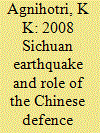

|
|
|
|
|
| Publication |
2012.
|
| Summary/Abstract |
The People's Republic of China has been afflicted by natural calamities right from its inception in 1949, including severe river flooding, excess snowfall, cyclones, tsunamis and earthquakes. The consequential human suffering is further aggravated by the heavy population density. The mammoth 2008 earthquake in Sichuan province and the resultant loss of life and property exposed the ill-preparedness of the Chinese government machinery like never before. Nevertheless, the Chinese State Council rose admirably to the occasion. The Peoples' Liberation Army (PLA) composed of military, armed police, militia and reserve troops was the single largest contributor to the emergency rescue, response and subsequent mitigation efforts. In the process, it encountered many obstacles, faced severe shortcomings, learnt valuable lessons and initiated measures to incorporate these lessons for better disaster preparedness in future. The PLA internalised disaster relief as one of its major tasks under the "military operations other than war" role. The situation in India-large population density and frequent occurrence of natural disasters-is similar to that of China. Thus, there are valuable lessons to be learnt from the Chinese experience of having suffered this earthquake and the methodology adopted, particularly by their armed forces, in disaster response, mitigation and capacity building for better management of mega disasters in future.
|
|
|
|
|
|
|
|
|
|
|
|
|
|
|
|
| 2 |
ID:
025485
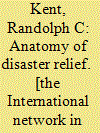

|
|
|
|
|
| Publication |
London, Printer Publishers, 1987.
|
| Description |
xii, 201p.
|
| Standard Number |
0861872940
|
|
|
|
|
|
|
|
|
|
|
|
Copies: C:1/I:0,R:0,Q:0
Circulation
| Accession# | Call# | Current Location | Status | Policy | Location |
| 029295 | 363.348/KEN 029295 | Main | On Shelf | General | |
|
|
|
|
| 3 |
ID:
069477
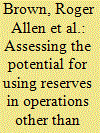

|
|
|
|
|
| Publication |
Santa Monica, Rand Corporation, 1997.
|
| Description |
xxiii, 80p.
|
| Standard Number |
0833024736
|
|
|
|
|
|
|
|
|
|
|
|
Copies: C:1/I:0,R:0,Q:0
Circulation
| Accession# | Call# | Current Location | Status | Policy | Location |
| 039516 | 355.370973/BRO 039516 | Main | On Shelf | General | |
|
|
|
|
| 4 |
ID:
137943
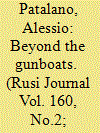

|
|
|
|
|
| Summary/Abstract |
In East Asia, the coercive use of maritime capabilities has led some to argue that the return of gunboat diplomacy has become inevitable. The use of coercion and deterrence there are indeed undeniable. However, Alessio Patalano argues that there is more than gunboats to diplomacy in a self-aware maritime East Asia. Capable navies can offer a significant contribution when dealing with major natural disasters, and these deployments should be regarded as diplomatic missions aimed at building relations and enhancing regional security. Japan's experience in this regard provides a relevant case in support of this argument.
|
|
|
|
|
|
|
|
|
|
|
|
|
|
|
|
| 5 |
ID:
159843
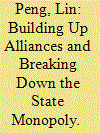

|
|
|
|
|
| Summary/Abstract |
This paper explores the emergence of a highly networked and capable non-governmental organization (NGO) community in disaster relief in China. It provides a review of the growth of non-governmental actors in the relief field since the 2000s and examines the most important platforms and networks in the field, focusing on their strategies of maintaining a broad-based partnership, developing their own capacity, and enhancing overall inter-organizational connectivity. With an in-depth look at a successful joint non-governmental relief operation in Lushan in 2013, the paper also explicates how NGOs can break the state monopoly over disaster information management, public donations and relief operations. This research finds that during crisis times, non-governmental actors carry out relief missions effectively in parallel with state agencies. The rise of non-governmental disaster relief sheds light on one of many trajectories of civil society development in China where social autonomy is earned by innovation, public support and improved capacity.
|
|
|
|
|
|
|
|
|
|
|
|
|
|
|
|
| 6 |
ID:
089291
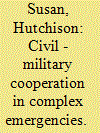

|
|
|
| 7 |
ID:
155874
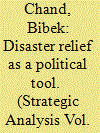

|
|
|
|
|
| Summary/Abstract |
In the aftermath of the 2015 earthquakes in Nepal, China and India immediately sent relief teams. The relief efforts in Nepal showcase a competitive aspect of the two major regional powers, as China seeks to gradually increase its influence in South Asia. This article analyses how these two governments utilised relief efforts to increase influence in Nepal, within the wider context of the contentious Sino–Indian relationship. The Chinese and Indian relief responses after the Nepal earthquakes are extrapolated to assess their strategic utility.
|
|
|
|
|
|
|
|
|
|
|
|
|
|
|
|
| 8 |
ID:
124663
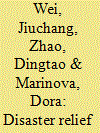

|
|
|
|
|
| Publication |
2013.
|
| Summary/Abstract |
The United States and China, as the largest developed country and the largest developing country in the world, respectively, have their own overt and covert influences on the world. This article discusses the foreign responses when the US was hit by the catastrophic Hurricane Katrina in 2005 and China by the Wenchuan earthquake in 2008. By using a three-stage process to describe disaster aid decisions, it was found that developed countries were more likely to grant disaster aid, but the scale of their assistance was not the largest. Evidence showed that countries were more likely to offer assistance if they were geographically located closer to the affected areas but this was not the case in decisions made on the type and amount of aid provided. Assistance from European countries, on the other hand, largely showed a form of cosmopolitan humanitarianism
|
|
|
|
|
|
|
|
|
|
|
|
|
|
|
|
| 9 |
ID:
104096
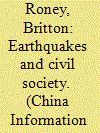

|
|
|
|
|
| Publication |
2011.
|
| Summary/Abstract |
The 2008 Wenchuan earthquake presents an opportunity to study certain aspects of civil society in China. Using the 1999 "921" earthquake in Taiwan as a point of comparison, the respective responses of nongovernment organizations (NGOs) to earthquakes in China and Taiwan can be used to elucidate the state of civil society in both countries. The surprisingly robust response to the Wenchuan earthquake by China's NGOs demonstrates the development of an increasingly sophisticated and professional NGO sector in China as well as a growing willingness on the part of the Chinese government to accept a limited role for NGOs in disaster relief, charity work, and the provision of social services. Comparison between the earthquake responses of NGOs in mainland China and Taiwan draws attention to the continued limitations of Chinese NGOs but also allows prediction of key trends in the future development of civil society in China. While Taiwan's highly autonomous and effective NGOs contrast with mainland China's semiautonomous NGOs, the similarities shared by organizations on both sides of the Taiwan Strait suggests that the development of China's civil society may in some ways parallel that of Taiwan.
|
|
|
|
|
|
|
|
|
|
|
|
|
|
|
|
| 10 |
ID:
082728
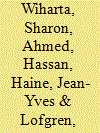

|
|
|
|
|
| Publication |
Solna, SIPRI, 2008.
|
| Description |
xvii, 139p.
|
| Standard Number |
9789185114573
|
|
|
|
|
|
|
|
|
|
|
|
Copies: C:1/I:0,R:0,Q:0
Circulation
| Accession# | Call# | Current Location | Status | Policy | Location |
| 053317 | 363.3480684/WIH 053317 | Main | On Shelf | General | |
|
|
|
|
| 11 |
ID:
142318
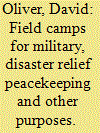

|
|
|
| 12 |
ID:
176226
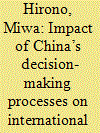

|
|
|
|
|
| Summary/Abstract |
International cooperation on peacekeeping operations, and on humanitarian assistance and disaster relief (HADR) operations, is important in tackling global non-traditional security threats. It also helps China address its ‘trust deficit’ problem. While both operations seem ‘low hanging fruit’ for international cooperation, the ways in which China undertakes peacekeeping and HADR cooperation differ – the former encompasses not only cooperation for technical and capacity development but also cooperation for policy harmonisation, while China’s HADR cooperation is limited to technical and capacity development. This paper asks, ‘why the difference?’, despite the fact that they both address similar policy problems. It argues that the difference corresponds to the level of holisticity/fragmentation of China’s decision-making process. The more holistic China’s decision-making process, the deeper the international cooperation. The nature of China’s decision-making processes has international policy implications, because the fragmented nature of those processes maintains cooperation at a functional level only, and hinders the deeper development of cooperation into policy harmonisation.
|
|
|
|
|
|
|
|
|
|
|
|
|
|
|
|
| 13 |
ID:
120688
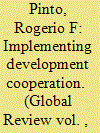

|
|
|
| 14 |
ID:
120246
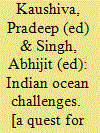

|
|
|
|
|
| Publication |
New Delhi, KW Publishers Pvt Ltd, 2013.
|
| Description |
xvii,168p.hbk
|
| Standard Number |
9789380502657
|
|
|
|
|
|
|
|
|
|
|
|
Copies: C:1/I:0,R:0,Q:0
Circulation
| Accession# | Call# | Current Location | Status | Policy | Location |
| 057271 | 355.033054/KAU 057271 | Main | On Shelf | General | |
|
|
|
|
| 15 |
ID:
144512
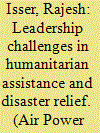

|
|
|
| 16 |
ID:
121155


|
|
|
|
|
| Publication |
2013.
|
| Summary/Abstract |
The success of any humanitarian aid mission is generally measured by the timeliness of critical supplies that are delivered to the affected area. However, a more interesting analysis may be to determine the effect of the aid on the overall satisfaction of the local population. The authors' research focused on the delivery of humanitarian aid to a notional region that was decimated by flooding with ships, landing craft and security personnel provided by the US Navy and Marines. While the research effort addressed naval force structure, the focus of the research was: (1) to assess different delivery methods for the aid; and (2) to determine how the aid delivery impacted the overall satisfaction of the local population. To examine both concerns, two simulation models were developed, with one examining the throughput of aid delivered during the operation, and the other the satisfaction of the population based on the humanitarian aid effort.
|
|
|
|
|
|
|
|
|
|
|
|
|
|
|
|
| 17 |
ID:
108134
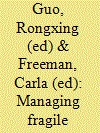

|
|
|
|
|
| Publication |
Washington, DC, Springer, 2010.
|
| Description |
xv, 174p.
|
| Standard Number |
9781441964359, hbk
|
|
|
|
|
|
|
|
|
|
|
|
Copies: C:1/I:0,R:0,Q:0
Circulation
| Accession# | Call# | Current Location | Status | Policy | Location |
| 056327 | 327.1/GUO 056327 | Main | On Shelf | General | |
|
|
|
|
| 18 |
ID:
182267
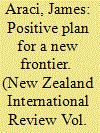

|
|
|
|
|
| Summary/Abstract |
The development of space technology has both provided a base to study the universe and improved the information we have about the Earth, aiding our daily lives. Both the United Kingdom's Integrated Review and new National Space Strategy represent significant shifts in our nation's strategic outlook and recognise the increasing role that technological innovation plays in our lives, the South Pacific and worldwide. Recent British space initiatives in the South Pacific region and our multilateral efforts to promote the responsible use of space illustrate the approach favoured by the United Kingdom. Space is emerging as a new paradigm for international engagement.
|
|
|
|
|
|
|
|
|
|
|
|
|
|
|
|
| 19 |
ID:
072691
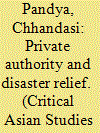

|
|
|
|
|
| Publication |
2006.
|
| Summary/Abstract |
This article explores the rise of private authority in globalized disaster relief scenarios by looking at the case of nongovernmental organizations (NGOs) operating in Aceh and its neighboring region, Nias, after the December 2004 Indian Ocean tsunami. The author places the growing strength and presence of NGOs within the larger context of weak, cash-strapped local governments under decentralization schemes promoted by neoliberal economic policies and argues that under such conditions, private actors such as NGOs are gaining a legitimacy of authority once reserved exclusively for the state. In Aceh after the tsunami, five hundred NGOs began operating relief and recovery efforts on the island with little consultation with local Acehnese government agencies and community organizations. The article concludes by arguing that the example of Aceh, in which public and private parallel systems of relief and recovery have been operating raises long-term issues of accountability for all parties involved.
|
|
|
|
|
|
|
|
|
|
|
|
|
|
|
|
| 20 |
ID:
186107
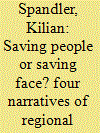

|
|
|
|
|
| Summary/Abstract |
ASEAN member states have invested substantially in cooperation on humanitarian assistance and disaster relief (HADR). Despite broad support for the idea of ‘localizing’ HADR governance, the rise of regional agency has in practice led to uncertainty and frictions between humanitarian stakeholders. The article makes sense of these tensions by investigating the narratives through which intra- and extraregional agents construct the role of the ASEAN Coordinating Centre for Humanitarian Assistance on Disaster Management (AHA Centre). Based on the assumption that narratives are central legitimating practices when new agents enter a governance arena, it analyzes textual material produced by different humanitarian organizations that operate in Southeast Asia, as well as interviews with representatives from these organizations. Their accounts of the AHA Centre’s role can be grouped into four narratives that are bound up with competing ideas about regional humanitarian order: an affirmative one, a skeptical one, a critical one and a transformative one. The article thus rejects characterizations of regional HADR as a rationally designed ‘architecture’ and instead defines it as a deeply political arena where different conceptions of order are asserted, contested and negotiated.
|
|
|
|
|
|
|
|
|
|
|
|
|
|
|
|
|
|
|
|
|